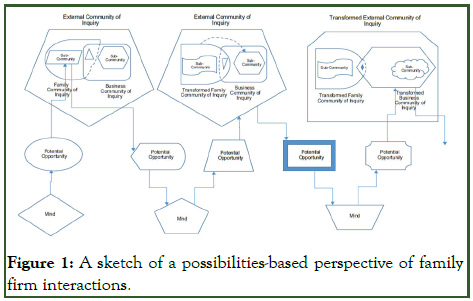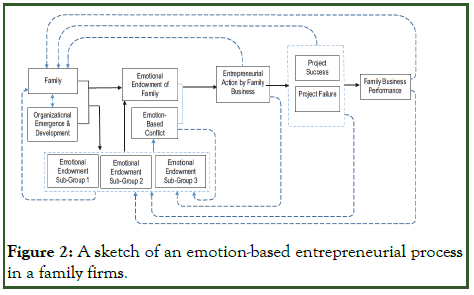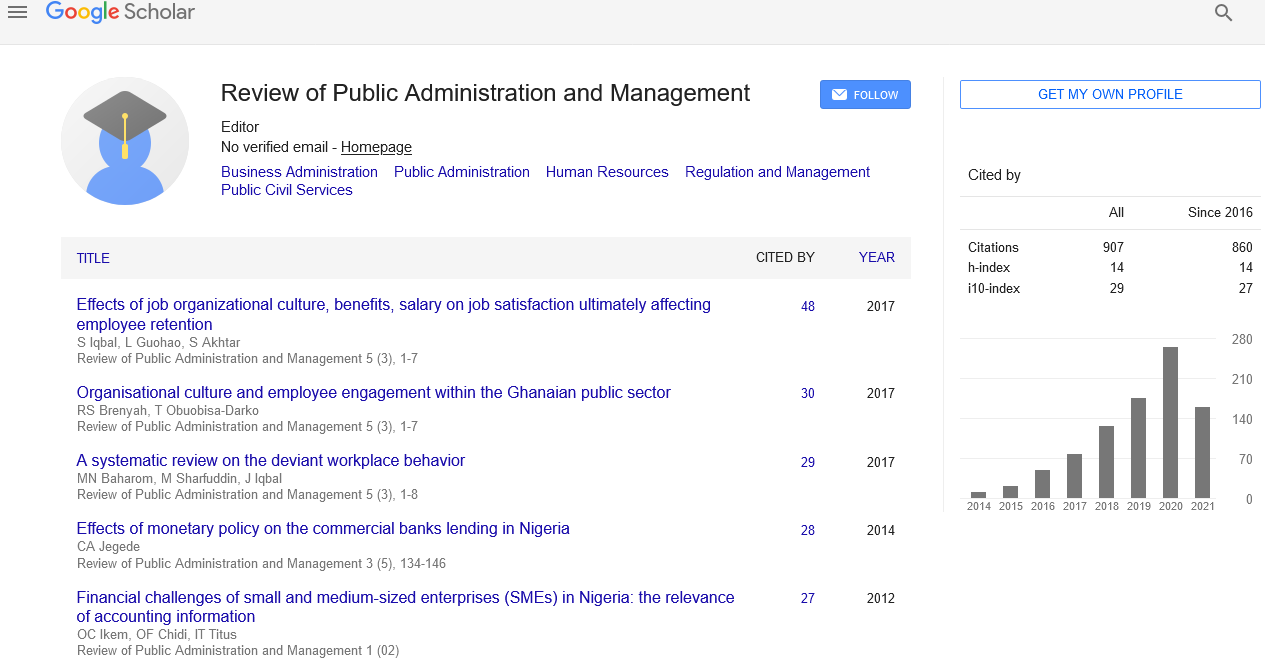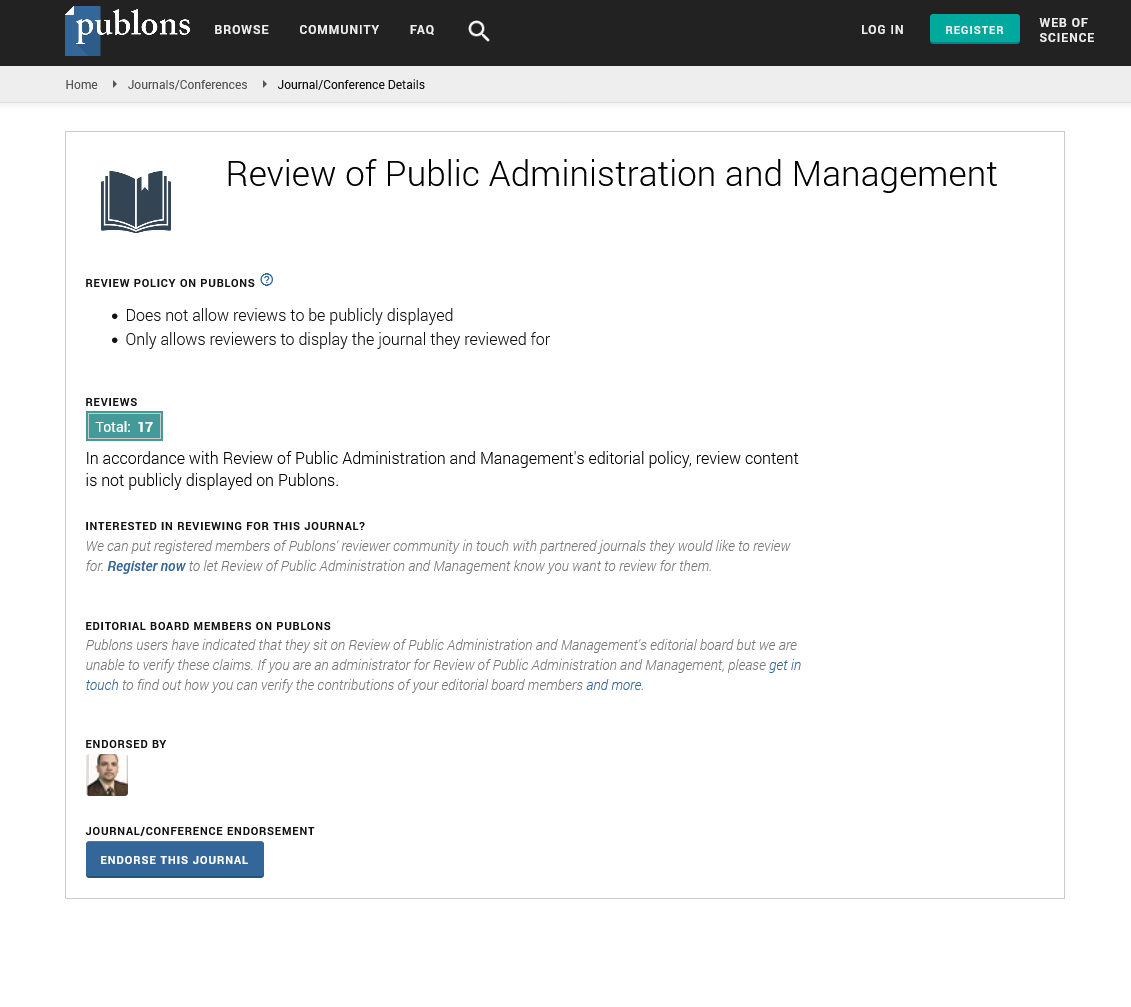Indexed In
- CiteFactor
- RefSeek
- Directory of Research Journal Indexing (DRJI)
- Hamdard University
- EBSCO A-Z
- Scholarsteer
- Publons
- Euro Pub
- Google Scholar
Useful Links
Share This Page
Journal Flyer

Open Access Journals
- Agri and Aquaculture
- Biochemistry
- Bioinformatics & Systems Biology
- Business & Management
- Chemistry
- Clinical Sciences
- Engineering
- Food & Nutrition
- General Science
- Genetics & Molecular Biology
- Immunology & Microbiology
- Medical Sciences
- Neuroscience & Psychology
- Nursing & Health Care
- Pharmaceutical Sciences
Review Article - (2024) Volume 12, Issue 4
A Review on Entrepreneur and Emotions in the Family Firm
Mohammad Heydari1*, Kin Keung Lai2 and Zhou Xiaohu12Department of Economics, Shenzhen University, Shenzhen, China
Received: 05-Sep-2019, Manuscript No. RPAM-24-2152; Editor assigned: 10-Sep-2019, Pre QC No. RPAM-24-2152 (PQ); Reviewed: 24-Sep-2019, QC No. RPAM-24-2152; Revised: 15-Jul-2024, Manuscript No. RPAM-24-2152 (R); Published: 12-Aug-2024, DOI: 10.35248/2315-7844.24.12.470
Abstract
In a world where so many people want to start a business and so many people want to believe that they are, maybe all our research has missed a very important point. Intent without the right action is not intent, it is dreaming. (Do I intend to start a business? Yes! Do I expect to start soon? Not necessarily). From the social intuitive point of view of the recognizable proof and refinement of potential possibilities, the "mind" alludes to an individual (implicitly independent of the firm context) and the "world" is outside to the individual (implicitly independent of the individual). The family firm background expects us to start to scrutinize these understood presumptions and along these lines raise possibilities for future research to make essential commitments.
Keywords
Family firm; Entrepreneur; Emotion; Mind; Action
Introduction
The family firm and enterprise writings have had some trade previously; nonetheless, this trade has been to a great extent restricted in degree (e.g., the expansion of a variable from one field into the other), getting in nature (e.g., the exchanged variable keeps up its underlying significance, frame and estimation) and uni-directional (i.e., contributing negligibly back to the source writing). In any case, thinks about joining these two literary works have made vital commitments to the two fields.
Here we choose to begin with a definition of intermediate specificity. “Entrepreneurial” intentions refer to the intent to start a business, to launch a new venture. It is important to select a level of specificity where heterogeneous samples will have adequately similar mental models of what the referent means. “I intend to start a business” need not match exactly with “I intend to be an entrepreneur” but the bulk of the empirical research to date appears to use this and we will use that as a starting point [1].
However, a nascent entrepreneur is committed (or believes she is) to a course of action. What do we gain if we identify nascency as the genuine “intending”? The careers literature distinguishes a stage prior to intent, “interest”. Might this also suggest a threestage phase change model: Interest, intent, launch? Even if this is too limiting, this thought suggests that we may want to think long and hard about where “intent” really begins?
Deep beliefs. However, if deep anchoring beliefs influence entrepreneurial intentions but influence differently as intentions evolve, then we might well identify different specifications for the model. Consider differences in motivation and volition, Heckhausen in this simple thought experiment suggested by Elfving, et al. One music entrepreneur believes “I am an entrepreneur. Therefore, I start a business.” The other believes “I am passionate about music. Being an entrepreneur enables that.” One has passion for entrepreneurship, the other for music, yet both start a music business. It might be relatively straightforward to identify what lies beneath those surface beliefs. Kets de Vries argued from a psychoanalytic perspective that all humans have critical core beliefs that trigger significant action [2].
Literature Review
Family firm research has a strong tradition of exploring social interactions. Specifically, because family firms often have both family and non-family owners, considerable attention has been paid to the interaction between principals and agents for issues related to conflicts of interest and asymmetric information. For instance, Schulze featured the office expenses of unselfishness guardians acting liberally toward their kids when running the firm and administration entrenchment relatives having secure positions in administration through killed inner control systems. Though inquire about dependent on stewardship hypothesis clarifies how operators act to the greatest advantage of the standards, relatives tend to put the prosperity of the firm over their very own prosperity. For instance, the directors (i.e., stewards) take part in professional authoritative practices that improve family firm execution and make an emotional network.
In spite of learning about the monetary and social trade from the family to other people, there is small comprehension of other business connections in family firms. In reality, inquire about on the between connections between the network and the on-screen character over potential possibilities gives a premise to an imperative commitment to the business enterprise and as we investigate underneath, this commitment can be accomplished through family firm research [3].
A potential possibility speaks to both a vehicle and a result of communication, the investigation of which in the family firm background can give the premise to critical commitments to the two fields. People can frame a conviction that a circumstance speaks to an possibilities for somebody and an possibilities for them particularly that is, third-and first-individual possibilities convictions, separately. By following up on this potential possibility, the individual draws in with a network to test (e.g., talk, test and endeavor) the veracity of the potential possibilities; thusly, a network of request (e.g., clients, providers and financers) gives criticism about the potential possibilities. This criticism can change the psyche of the person, which would then be able to change the idea of the potential possibilities and, through connections with the appearances of the potential outcomes, change the network of a request. This thought of shared alteration between the brain and the world through testing and refining potential possibilities can illuminate (and be educated by) family firm research [4].
Communities within the family firm
While research has typically considered the community of inquiry to be external and somewhat independent of the individual identifying and refining the possibilities, a shift to the family firm context offers a different perspective on the community of inquiry. For example, a community of inquiry could be considered more internal when it involves other members of the firm and/or other members of the family. Given that potential possibilities can be refined through interaction with a community of inquiry, what happens when there are multiple communities of inquiry and each provides different feedback? The different feedback provides a basis for refining the possibilities in different ways a fork in the road. Which path is chosen, why and with what consequence? Perhaps it is less about consciously choosing a path but choosing the community of inquiry with which to remain engaged. Indeed, by pursuing one of the directions for refining the potential possibilities, both communities of inquiry may be transformed but in different ways. Therefore, the process of refining potential possibilities may lead to the transformation of the firm (as a community of inquiry) and the family (as a community of inquiry) in ways that create a divergence between the family and the firm where there once was convergence. This idea has suggestions for future research on the age, assessment and refinement of potential open doors in the family firm context.
If a potential possibility is a source of transformation that creates a divergence between the family and the firm in some family firms, then perhaps it can also be a source of convergence in other family firms. That is, for family firms with little coinciding between the family and firm sub-frameworks, the recognizable proof and refinement of a potential possibilities might be a vehicle for changing the networks to such an extent that there is more cover between the two, thereby resolving the "disconnect" in particular, putting them both in agreement. As opposed to making two immovables yet restricting "mindsets," potential possibilities can speak to a vehicle for collaboration through which the potential possibilities is refined. In this manner, the networks of a request are changed, thus closing the “mindset” gap. Future research can decide if this procedure of assembly prompts a bargain of tradeoffs or a win-win circumstance [5].
Family members’ choices of internal communities
Over and above the interaction with the external community of inquiry and between the family and the firm communities of inquiry, the process of refining potential possibilities will likely have an impact at the inter-personal level within both of the family firm’s sub-systems. Here, we can focus on the unique aspect of the family firm context of the family. When a member of the family firms a possibilities belief, how does he or she “test” it with other family members, change his or her conceptualization of the potential possibilities (in line with feedback) and reflect that changed conceptualization in refinements to the nature of the potential possibilities? How do these refinements then transform the group of family members acting as a community of inquiry? Perhaps the individual with the initial idea of potential possibilities can choose or create this first community of inquiry. Maybe the family is utilized first as a network of request since they are proximal and vested. On the other hand, the principal network of query could be a littler subgather inside the family, a littler sub-gathering of non-family firm individuals or an outer (i.e., outside the family firm) network of the query before the family is drawn nearer all in all. As alluded to in the previous paragraph, the differential transformation of communities through a potential possibilities refinement may complicate a sequential process of advancing from one community to the next. Indeed, although the generation of potential possibilities likely starts with one community or the other, this possibilities process likely continues in a highly iterative process by which possibilities refinement occurs through interactions within and between these different communities, which are themselves being transformed by the process [6].
Emotions, entrepreneurship and family firms
Our underlying contentions are grounded in socio-emotional riches (as spoke to in the family firm writing) yet in addition mirror, a more extensive reasoning with respect to the broader job emotion plays at the convergence of family firm and business. In this unique circumstance, emotion alludes to abstract inclination states with an unmistakable reason or question, a brief term, and an attention on a particular target. We trust future research can make generous commitments to the family firm and enterprise fields (and past) by investigating the distinctive jobs emotion plays [7].
Emotional reactions to failure
Family firm scientists have invested significant energy examining the negative impacts of the misfortune (or threatened loss) of socio-emotion riches on basic leadership and enterprise analysts have contemplated the negative impacts of the loss of an innovative undertaking (i.e., a task or a firm) on basic leadership; notwithstanding, shockingly, there has been little cover between the two fields. Given their comparative advantages, cross-preparation will probably profit the two fields. Specifically, higher supplies of emotions could lead firm individuals to continue in firm undertakings regardless of poor execution. In any case, such ingenuity may make disappointment costlier on the off chance that it occurs or, in other words, adverse effect the family's (and its members') wellbeing. In addition, as the family puts more noteworthy emotion stocks in the firm, the firm is probably going to develop in significance among relatives, therefore creating more sorrow if disappointment occurs. This subsequent sadness could make relatives endure longer, learn less and be less roused to attempt again after a disappointment. Then again, a portion of the emotion stocks that prompted tirelessness could likewise fill in as a way to adapt to misery. To be specific, when looked with sorrow over the enterprising disappointment, firms with higher emotion stocks might have the capacity to help relatives all the more rapidly diminish anguish, gain from the disappointment and attempt once more. Nonetheless, firm disappointment could likewise demolish or significantly modify the family's (and family members’) set of emotion-related qualities. These guesses are for the most part theories now. Additionally, inquire about is required on the emotion supplies of the family (as well as the people and gatherings inside the family) and on the fizzling or potentially disappointment of pioneering attempts (i.e., ventures or firms) [8].
Emotional responses to others’ suffering, entrepreneurship and family firms
Researchers have found that when the family has influence in managing the firm, resulting firm decisions are generally more socially responsible and reflect stronger notions of community citizenship. The driving force of such “socially responsible” behavior is likely prosocial motivation an individual’s desire to expend effort to assist (i.e., protect or promote the welfare of) other people. What's more, firms can take part in prosocial behavior through empathy sorting out: "A collective response to a particular incident of human suffering that entails the coordination of individual compassion". Empathy sorting out alludes to associations' repurposing and diverting schedules utilized for typical work to rapidly react to representatives in need to help lighten their anguish, for example, the university of Michigan's reaction to the torment caused to understudies by a fire on grounds [9].
In any case, there are times when the association's present schedules and procedures don't line up with the necessities related with a part's torment. In such cases, the family inside (and perhaps reaching beyond) the limits of the firm might have the capacity to offer the schedules and procedures important to facilitate the authoritative part's affliction. That is, the family can fill in as the establishment for arranging the recognizable proof and misuse of potential possibilities outcomes to lighten the part's affliction. Similarly, as with any firm errand, it is likely that a few families are preferable at empathy sorting out over others. For example, families that confronted enduring in the past could have more grounded sympathy sorting out capacities in the family firm setting than families without such experience [10].
Discussion
Although there are many research possibilities at the intersection of the entrepreneurship and family firm fields, in this paper, we offered three potential future areas that we believe can considerably advance both fields by combining and blending constructs and relationships specific to one field with those of the other field.
In sum, we can learn a great deal about the process of possibilities identification and refinement by exploring social interactions in the family firm context and thereby make important contributions to theory. We can also learn a great deal about transformations of the family and the firm by exploring the identification and refinement of possibilities [11].
In Figure 1, we offer a sketch of an example of a more possibilities-based perspective of family firm interactions as a basis for guiding future research. Although there are likely many potential future research contributions arising from studies of the interactions occurring in the family firm context, we propose that important avenues for future research include addressing the following questions: (1) How does testing the veracity of a family firm’s potential possibilities in a community of inquiry transform the family, firm and/or external community? (2) How does the transformation of the family community of inquiry and/or the firm community of inquiry refine the nature of the potential possibilities? (3) How does the transformation of the firm community of inquiry (through the refinement of potential possibilities) transform the family community of inquiry and vice versa? (4) How and when does the refinement of potential possibilities lead to convergence of the family and firm (or convergence within either sub-system)? (5) How and when does the refinement of potential possibilities lead to divergence of the family and the firm (or divergence within either sub-system)? (6) Finally, how does the sequence of engaging different communities of inquiry impact the evolution of the potential possibilities and the mind of the originator of the idea? In Figure 2, we offer a sketch of an emotion-based entrepreneurial process in a family firm as a basis for guiding future research [12].

Figure 1: A sketch of a possibilities-based perspective of family firm interactions.

Figure 2: A sketch of an emotion-based entrepreneurial process in a family firms.
Conclusion
The creation of a family firm begins with the family and some level of organizing (a nascent organization) and includes an emotional endowment that influences the extent of the entrepreneurial action. Entrepreneurial action, at the project level, can lead to success or failure and these project outcomes influence the overall performance of the family firm. The family firm’s emotional endowment is made up of the emotional endowment of its various sub-groups. Differences in emotional endowments can lead to conflict, which can in turn influence entrepreneurial action and the sub-groups’ emotional endowment from which the conflict originally arose. Indeed, the emotional endowment of the family’s sub-groups is influenced by the family firm’s entrepreneurial action, project outcomes and performance. Similarly, the nature of the family firm itself can be influenced by the family firm’s entrepreneurial action, project outcomes and performance.
Acknowledgments
I am deeply thankful to my colleague and friend to PhD candidate Ying Chen who have contributed to clarify and improve the paper thanks to their constructive and insightful comments.
References
- Ajzen I. Attitudes, traits and actions: Dispositional prediction of behavior in personality and social psychology. Adv Exp Soc Psychol. 1987;20:1-63.
- Arregle JL, Hitt MA, Sirmon DG, Very P. The development of organizational social capital: Attributes of family firms. J Manag Stud. 2007;44(1):73-95.
- Autio E, Dahlander L, Frederiksen L. Information exposure, opportunity evaluation and entrepreneurial action: An investigation of an online user community. Acad Manag J. 2013;56(5):1348-1371.
- Berrone P, Cruz C, Gomez-Mejia LR, Larraza-Kintana M. Socioemotional wealth and corporate responses to institutional pressures: Do family-controlled firms pollute less? Adm Sci Q. 2010;55(1):82-113.
- Cabrera-Suarez K, de Saa-Parez P, Garcia-Almeida D. The succession process from a resource-and knowledge-based view of the family firm. Family Business Rev. 2001;14(1):37-46.
- Cornelissen JP, Clarke JS. Imagining and rationalizing opportunities: Inductive reasoning and the creation and justification of new ventures. Acad Manag Rev. 2010;35(4):539-557.
- Cruz CC, Gomez-Mejia LR, Becerra M. Perceptions of benevolence and the design of agency contracts: CEO-TMT relationships in family firms. Acad Manag J. 2010;53(1):69-89.
- Donaldson L, Davis JH. Stewardship theory or agency theory: CEO governance and shareholder returns. Aust J Manag. 1991;16(1):49-64.
- Dutton JE, Worline MC, Frost PJ, Lilius J. Explaining compassion organizing. Adm Sci Q. 2006;51(1):59-96.
- Dyer Jr WG, Whetten DA. Family firms and social responsibility: Preliminary evidence from the S and P 500. Entrepreneurship Theory Pract. 2006;30(6):785-802.
- Gagne M, Sharma P, de Massis A. The study of organizational behaviour in family business. Eur J Work Org Psychol. 2014;23(5):643-656.
- Goel S, Jones III RJ. Entrepreneurial exploration and exploitation in family business: A systematic review and future directions. Family Business Rev. 2016;29(1):94-120.
Citation: Heydari M, Lai KK, Xiaohu Z (2024) A Review on Entrepreneur and Emotions in the Family Firm. Review Pub Administration Manag. 12:470.
Copyright: © 2024 Heydari M, et al. This is an open-access article distributed under the terms of the Creative Commons Attribution License, which permits unrestricted use, distribution, and reproduction in any medium, provided the original author and source are credited.


